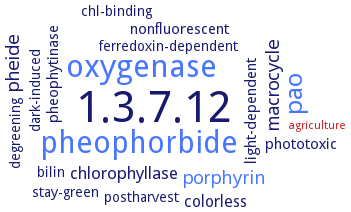1.3.7.12: red chlorophyll catabolite reductase
This is an abbreviated version!
For detailed information about red chlorophyll catabolite reductase, go to the full flat file.

Word Map on EC 1.3.7.12 
-
1.3.7.12
-
oxygenase
-
pheophorbide
-
pao
-
macrocycle
-
porphyrin
-
pheide
-
chlorophyllase
-
colorless
-
pheophytinase
-
phototoxic
-
nonfluorescent
-
light-dependent
-
ferredoxin-dependent
-
dark-induced
-
stay-green
-
bilin
-
degreening
-
chl-binding
-
postharvest
-
agriculture
- 1.3.7.12
- oxygenase
- pheophorbide
- pao
-
macrocycle
- porphyrin
-
pheide
- chlorophyllase
-
colorless
-
pheophytinase
-
phototoxic
-
nonfluorescent
-
light-dependent
-
ferredoxin-dependent
-
dark-induced
-
stay-green
-
bilin
-
degreening
-
chl-binding
-
postharvest
- agriculture
Reaction
Synonyms
ACD2 protein, At-RCCR, AtRCCR, BoRCCR, BrRCCR, CaRCCR, EC 1.3.1.80, HvRCCR, PHAVU_008G280300g, RCC reductase, RCCR, RCCR-1, RCCR-2, red Chl catabolite reductase, red chlorophyll catabolite reductase, red-chlorophyll-catabolite reductase
ECTree
Advanced search results
Expression
Expression on EC 1.3.7.12 - red chlorophyll catabolite reductase
Please wait a moment until all data is loaded. This message will disappear when all data is loaded.
1-methylcyclopropene (1-MCP) alone or in combination with chlorine dioxide (ClO2) on the chlorophyll degradation pathway of green pepper at the molecular level remains scarce. Green peppers treated with 1-MCP, ClO2 alone, and 1-MCP plus ClO2, respectively and stored at 20°C for 12 days, show that the 1-MCP + ClO2 combination is superior in inhibiting color changes, decreasing the respiration rate, and exhibiting chlorophyll content as compared with 1-MCP or ClO2 alone. Phenotype, overview. Methylcyclopropene (1-MCP) and chlorine dioxide (ClO2) both inhibit the RCCR enzyme expression in green pepper. Synergistic inhibitory effect of 1-MCP and ClO2 treatment on chlorophyll degradation of green pepper fruit during storage, pheophytinase (PPH), pheophorbide a oxygenase (PAO), and red chlorophyll catabolite reductase (RCCR) are suppressed by all treatments. ClO2 treatment dramatically downregulates the mRNA levels of CaRCCR at 3 and 6 d, overview
after senescence induction RCCR and other chlorophyll catabolic enzymes are significantly higher expressed in the pheophytinase-GFP overexpressing plants than in the wild-type plants
-
Chl degradation in ethylene-treated cabbage is faster than it is in control leaves, strong activation in the expression of the enzyme, as well as of the other two chlorophyll degradation related genes, pheophytinase (BrPPH) and pheophorbide a oxygenase (BrPAO), in control and ethylene-treated leaves. After 7 days, leavese the entire cabbages, except for the young leaves at the top, in control and ethylene treatment turn yellow
downregulation of expression of chlorophyll degradation related genes, pheophytinase (BrPPH), pheophorbide a oxygenase (BrPAO), and RCC reductase (RCCR) by 6-benzyl aminopurine. After 7 days, leaves in 6-BA treatment display lightly yellowing, while the entire cabbages, except for the young leaves at the top, in control leaves turn yellow
ethylene and 1-methylcyclopropene (1-MCP) treatment downregulate red Chl catabolite reductase (RCCR) in peel tissues during ripening, quantitative real-time polymerase chain reaction reveals that the expression of CCGs, except for MdNYE1a, increases at different degrees upon ripening. The apples treated with 1-MCP present a downregulated expression of MdRCCR2, MdNYC1, MdNYC3 and MdNOL2 and a fluctuating expression of MdNYE1a, MdPPH1, MdPAO6, MdPAO8 and MdHCAR compared with the controls during ripening
-
expression levels of red chlorophyll catabolite reductase (RCCR) are enhanced at an early stage (2 cm long) in wild-type but not in green pod mutants
melatonin treatment significantly suppresses the RCCR expression, which reduces the enzyme activity in melatonin-treated florets compared to levels in control florets throughout the whole storage
-
RCCR is not an inducible gene upon dark treatment, whereas its transcript level is slightly reduced during senescence. RCCR is constitutively active and its activity is rather constant during all phases of leaf development
-
the enzyme is upregulated by abscisic acid, methyl jasmonate, and salicylic acid, and it is induced by high salinity and drought stress treatments. The enzyme expression is also slightly increased when the pepper plants are infected with Phytophthora capsici strain HX-9


 results (
results ( results (
results ( top
top





